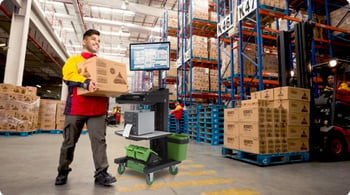
Quiet quitting has become a common term in this country over the past year. While possibly more prevalent in other industries, the warehouse industry is not immune from the practice. According to a recent Gallup survey, a mere one-third of employees are engaged at work. Are you seeing a slowdown in productivity in your warehouse? It may be time to evaluate the satisfaction of your employees.
What is “Quiet Quitting” and Why is it Happening?
When you hire an employee, you expect that they’ll meet certain expectations. But when a warehouse or distribution center has so many rigid requirements that meeting them seems next to impossible, you’d think they’d look for employment elsewhere. But, a recent trend suggests that something else is happening — quiet quitting.
Quiet quitting describes a spectrum of behaviors workers exhibit when they become frustrated with workplace conditions, unfair workloads, or toxic company cultures. It can include anything from creating boundaries to completely withdrawing from their duties and team but still being physically present. Some examples of quiet quitting in the warehouse include:

- Not meeting regular goals
- Not being willing to train new hires
- No longer volunteering for overtime
- Isolating from other warehouse workers
- Making frequent negative comments about the company or job
- No longer providing feedback during training or meetings
The term “quiet quitting” might have become popular on social media. But it’s become a real thing that impacts businesses in just about every industry. So, why are people deciding to disengage at work? Here are some of the most common reasons, according to a Sprout Social study:
- Layoff threats and wage cuts
- Poor relationship with management
- Unfair expectations at work
- No opportunities for promotions or raises
- New employees (with less experience) getting higher earnings
- Negative opinion of company culture
- No feelings of purpose
Is quiet quitting happening in your warehouse? If you have the same number of employees, but productivity has dropped significantly, there’s a good chance you have an issue. Employees will stop going the extra mile to meet goals. If they’re still getting paid the same wage, those attitudes can become contagious.
How You Can Avoid Quiet Quitting in the Warehouse
Some warehouse managers might be tempted to simply fire any employees who no longer seem engaged. But that doesn’t solve the underlying issue. Any new employees you hire might become just as disillusioned in a short period and decide that quiet quitting would be a great idea.
If you want to avoid quiet quitting in your warehouse or reverse a negative trend, you’ll need to make some fundamental changes. Here are some tips for keeping your workers engaged and boosting overall employee satisfaction.
1. Offer Better Compensation & Perks
First, make sure you are paying a competitive wage for your industry and region. This includes wages plus benefits. If you aren’t, you need to update this immediately. Another way to inspire your workers and stand out among your competitors is to offer a variety of perks. Some examples include:
- Free meals
- Free coffee/snacks
- Indoor or outdoor break spaces
- Access to gym equipment
- Non-performance-related prizes or contests, such as event tickets
- Merchandise discounts
2. Address Employee Burnout
 Quiet quitting is directly related to job burnout in most organizations. Unless you address this specific issue, you’ll continue to have workers who disengage. Even worse, a portion of those employees will simply leave for greener pastures.
Quiet quitting is directly related to job burnout in most organizations. Unless you address this specific issue, you’ll continue to have workers who disengage. Even worse, a portion of those employees will simply leave for greener pastures.
If you’re not offering employees paid time off (PTO) or make it difficult for them to schedule a break, find a way to fix this. You might need to bring in temporary help to cover workers who go on vacation.
Beyond giving employees deserved breaks, consider how else you can take some of the load off of their plates. This might involve hiring more workers or investing in technology solutions, which we discuss below.
3. Engage Warehouse Employees
If you don’t know what your employees want, ask them. Listening to negative feedback might be uncomfortable, but it’s the best way to foster true change. Consider conducting an anonymous survey so workers feel comfortable providing candid feedback about what they feel needs improvement.
You can also start sitting down with your employees individually to discuss their goals and specific challenges. When employees see that you are willing to take the time to do this, many will re-engage, providing the business with the productivity it needs.
4. Improve Your Company Culture
Company culture is another issue your warehouse may need to address. When you review that internal feedback, you should come up with a list of things that may be lacking in your business. For example, do your employees feel underappreciated by their supervisors? If so, put a recognition program in place. Is there no room for advancement in your company? It may be time to create a cross-training or management training program. Are workers feeling like they’re being micromanaged? Instead, provide employees with clear instructions and goals and give them the freedom to work efficiently.
5. Implement Technology Solutions
Nothing is more frustrating to a warehouse employee than having to do a job with processes that makes completing each task harder than necessary. In a competitive labor market, employees are quick to notice when a competitor has technology that makes the same job easier and safer.
 This doesn’t mean you need to invest in an army of robots to handle all warehouse tasks. But providing various technology solutions that make work easier can boost morale and productivity. For example, mobile powered carts in the warehouse can save your workers thousands of steps daily by bringing the technology where they need to be on the floor. Combined with RFID technology, these tools can reduce errors and improve overall employee satisfaction.
This doesn’t mean you need to invest in an army of robots to handle all warehouse tasks. But providing various technology solutions that make work easier can boost morale and productivity. For example, mobile powered carts in the warehouse can save your workers thousands of steps daily by bringing the technology where they need to be on the floor. Combined with RFID technology, these tools can reduce errors and improve overall employee satisfaction.
If you are experiencing these problems in your warehouse, it’s not because your employees are following a popular trend. Quiet quitting is a way for your workers to deal with burnout. It’s something you need to address quickly and appropriately, or your labor-related challenges will only worsen. Fortunately, these tips, which include implementing various technology solutions, will improve employee satisfaction and improve your overall results.

